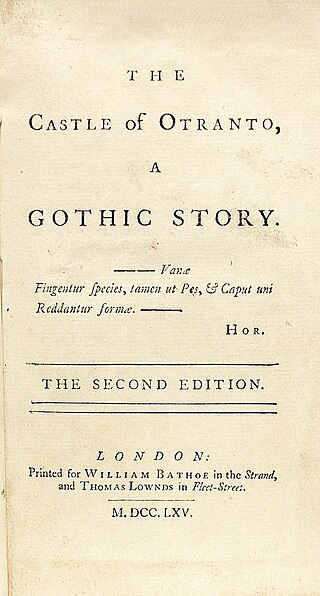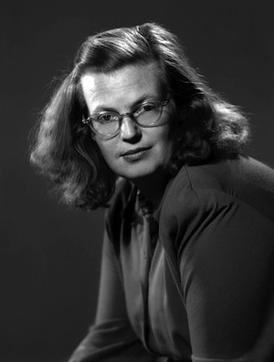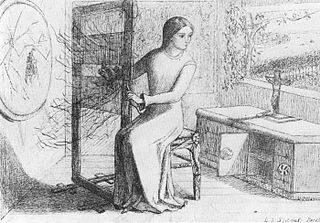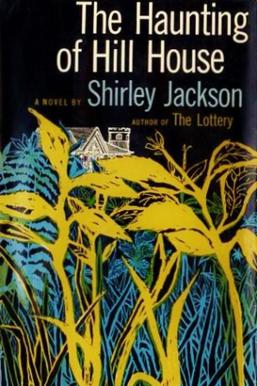
Gothic fiction, sometimes called Gothic horror, is a loose literary aesthetic of fear and haunting. The name refers to Gothic architecture of the European Middle Ages, which was characteristic of the settings of early Gothic novels.

Edward Frederic Benson was an English novelist, biographer, memoirist, historian and short story writer.

"The Masque of the Red Death" is a short story by American writer Edgar Allan Poe, first published in 1842. The story follows Prince Prospero's attempts to avoid a dangerous plague, known as the Red Death, by hiding in his abbey. He, along with many other wealthy nobles, hosts a masquerade ball in seven rooms of the abbey, each decorated with a different color. In the midst of their revelry, a mysterious figure disguised as a Red Death victim enters and makes his way through each of the rooms. Prospero dies after confronting this stranger, whose "costume" proves to contain nothing tangible inside it; the guests also die in turn.

Shirley Hardie Jackson was an American writer known primarily for her works of horror and mystery. Her writing career spanned over two decades, during which she composed six novels, two memoirs, and more than 200 short stories.

Peter Francis Straub was an American novelist and poet. He had success with several horror and supernatural fiction novels, among them Julia (1975), Ghost Story (1979) and The Talisman (1984), the latter co-written with Stephen King. He explored the mystery genre with the Blue Rose trilogy, consisting of Koko (1988), Mystery (1990) and The Throat (1993). He fused the supernatural with crime fiction in Lost Boy, Lost Girl (2003) and the related In the Night Room (2004). For the Library of America, he edited the volume H. P. Lovecraft: Tales and the anthology American Fantastic Tales. Straub received such literary honors as the Bram Stoker Award, World Fantasy Award, and International Horror Guild Award.

"The Lady of Shalott" is a lyrical ballad by the 19th-century English poet Alfred Tennyson and one of his best-known works. Inspired by the 13th-century Italian short prose text Donna di Scalotta, the poem tells the tragic story of Elaine of Astolat, a young noblewoman stranded in a tower up the river from Camelot. Tennyson wrote two versions of the poem, one published in 1832, of 20 stanzas, the other in 1842, of 19 stanzas, and returned to the story in "Lancelot and Elaine". The vivid medieval romanticism and enigmatic symbolism of "The Lady of Shalott" inspired many painters, especially the Pre-Raphaelites and their followers, as well as other authors and artists.

The Bloody Chamber is a collection of short fiction by English writer Angela Carter. It was first published in the United Kingdom in 1979 by Gollancz and won the Cheltenham Festival Literary Prize. The stories are all based on fairytales or folk tales. However, Carter has stated:
My intention was not to do 'versions' or, as the American edition of the book said, horribly, 'adult' fairy tales, but to extract the latent content from the traditional stories.

The Haunting of Hill House is a 1959 gothic horror novel by American author Shirley Jackson. It was a finalist for the National Book Award and has been made into two feature films, a play, and is the basis of a Netflix series.
"The Possibility of Evil" is a 1965 short story by Shirley Jackson. Published on December 18, 1965, in the Saturday Evening Post, a few months after her death, it won the 1966 Edgar Allan Poe Award for best mystery short story. It has since been reprinted in the collections Just an Ordinary Day (1996) and Dark Tales (2016).

First Love: A Gothic Tale is a novella by American novelist and essayist Joyce Carol Oates and illustrator Barry Moser. It tells the story of Josie S_____, a girl who goes to stay at her aunt's mansion in upstate New York. While there, she has an incestuous relationship with her cousin, Jared. The novella deals with two of the more common recurring themes in Oates' work: "teenage initiation and perplexing and problematic love."

Joan Cooper, known by her pen name, J. California Cooper, was an American playwright and author. She wrote 17 plays and was named Black Playwright of the Year in 1978 for her play Strangers. Cooper also received an American Book Award in 1989, a James Baldwin Writing Award (1988), and a Literary Lion Award (1988) from the American Library Association.

Weston Woods Studios is a production company that makes audio and short films based on well-known books for children. It was founded in 1953 by Morton Schindel in Weston, Connecticut, and named after the wooded area near his home. Weston Woods Studios' first project was Andy and the Lion in 1954, and its first animated film was The Snowy Day in 1964. In 1968, Weston Woods began a long collaboration with animator Gene Deitch. Later, they opened international offices in Henley-on-Thames, England, UK (1972), as well as in Canada (1975), and in Australia (1977). In addition to making the films, Weston Woods also conducted interviews with the writers, illustrators, and makers of the films. The films have appeared on children's television programs such as Captain Kangaroo, Eureeka's Castle, and Sammy's Story Shop. In the mid-1980s, the films were released on VHS under the Children's Circle titles, and Wood Knapp Video distributed these releases from 1988 to 1995.

American Gothic Tales is an anthology of "gothic" American short fiction. Edited and with an Introduction by Joyce Carol Oates, it was published by Plume in 1996. It featured contributions by Washington Irving, Nathaniel Hawthorne, Edgar Allan Poe, Stephen King, Anne Rice and others, and included over 40 stories.
American gothic fiction is a subgenre of gothic fiction. Elements specific to American Gothic include: rationality versus the irrational, puritanism, guilt, the uncanny, ab-humans, ghosts, and monsters.
Exotic Gothic is an anthology series of original short fiction and novel excerpts in the gothic, horror and fantasy genres. A recipient of the World Fantasy Award and Shirley Jackson Awards, it is conceptualized and edited by Danel Olson, a professor of English at Lone Star College in Texas.

Come Along with Me is a posthumous collection of works by American writer Shirley Jackson. It contains the incomplete titular novel, on which Jackson was working at the time of her death, three lectures delivered by Jackson, and sixteen short stories, mostly in the gothic genre, including Jackson's best known work, "The Lottery".
American Fantastic Tales is a set of two reprint horror anthologies, released as American Fantastic Tales: Terror and the Uncanny from Poe to the Pulps and American Fantastic Tales: Terror and the Uncanny from the 1940s to Now. Both anthologies were edited by Peter Straub. They were published by Library of America in 2009. The anthologies contain horror stories by American authors from the 18th century to modern times, split at 1940. The anthology pair itself won the 2010 World Fantasy Award—Anthology. The pair were also released as a boxed set in 2009.

The Bird's Nest is a 1954 novel by Shirley Jackson. The plot concerns a young woman, Elizabeth Richmond, with multiple personality disorder.
"Louisa, Please Come Home" is a short story by Shirley Jackson first published in 1960 in May's edition of Ladies Home Journal entitled "Louisa, Please". It has since been reprinted in the collections Come Along with Me (1968), Troubled Daughters, Twisted Wives and Dark Tales (2016).












